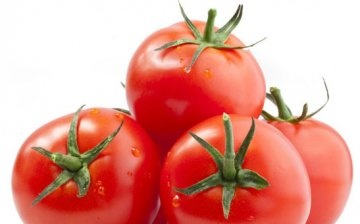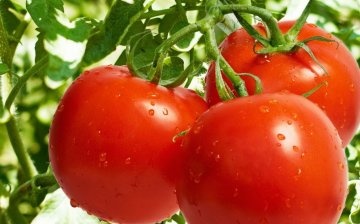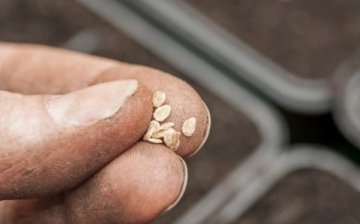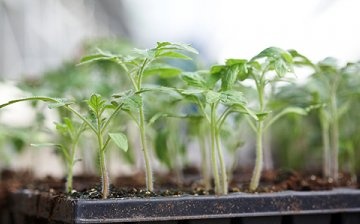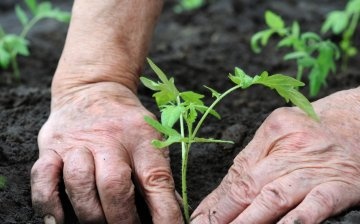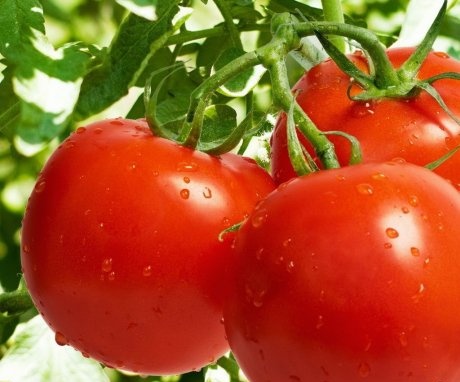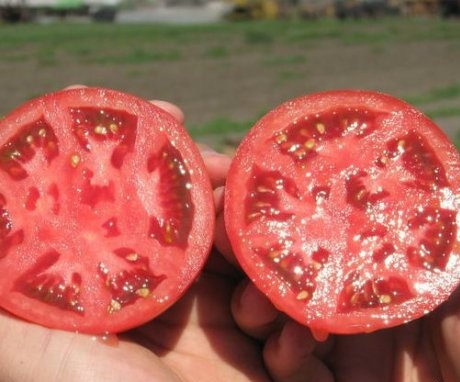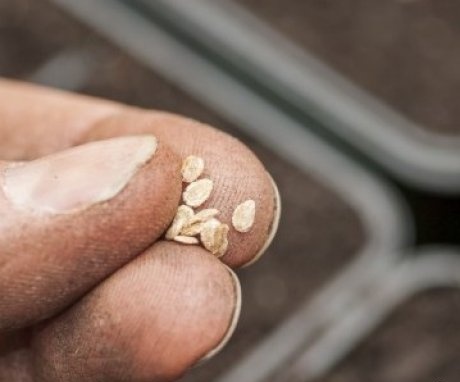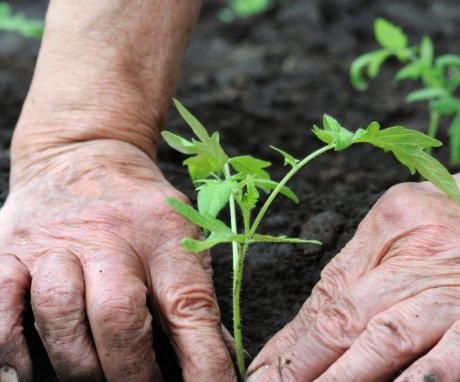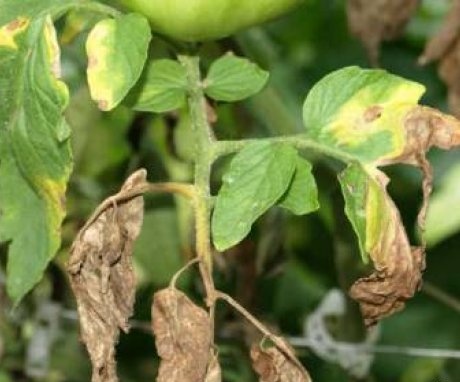Tomato Perseus: the best determinant mid-season variety
Varieties tomato can be conditionally divided into two groups: hybrids and varietal. Hybrids are distinguished by their large size and number of fruits, ordinary varieties have excellent taste. Tomato Perseus belongs to the second group.
Content:
- Tomato Perseus: variety description
- Seed preparation
- Growing seedlings
- Transplanting seedlings into the ground and care
- Diseases and pests of tomato Perseus
Tomato Perseus: variety description
The Perseus tomato variety has been known since the end of the 19th century. It was created in Moldova. A variety of medium ripening. The period from the emergence of shoots to the ripening of the first fruits is at least 110 days. Tomatoes quite large. They reach 110-180 g. The first are larger, the subsequent ones grow smaller. In shape, they are rounded, slightly flattened. The pulp is firm, of excellent taste. Fruit color is bright red. Near the stalk - green. There are 5-7 chambers with seeds inside the fruit. It is juicy, the amount of dry matter is small.
Tomato Perseus is a determinant (undersized) variety, its bushes are up to 60 cm high.
Plants are quite vigorous for determinate ones, with a lot of leaves. Each inflorescence reaches from 3 to 5 fruits. The first is formed under the sixth sheet. The variety has a wide range of uses. Tomatoes are eaten fresh, salted, canned. They make juice, tomato paste. Tomatoes have a dense skin, so they are well stored, which allows them to be transported.
The advantages of the variety:
- Great fruit taste.
- Large fruit size.
- The ability to transport.
- Disease resistance.
- Grown in vegetable gardens and greenhouses.
Seed preparation
Seed procurement is treated with special attention. You can buy them in the store or assemble them yourself. Tomato Perseus does not belong to hybrid varieties. Therefore, it can be grown from seeds of past harvests. It's not enough to take a beautiful fruit and collect seeds from it. You need to know for sure that it is collected from a healthy bush.
For seeds, fruits are taken from the first ovary of plants with the largest number of fruits.
Place the tomatoes intended for seeds in a warm place and wait until they become soft. Then the seeds are selected, washed in running water and dropped onto a sieve. Spread out on paper or fabric so that they dry well (not in a bunch). After a couple of days, they hide them in a paper bag, sign and store them. The package indicates the variety of seeds and the year in which they were harvested. Tomato seeds do not lose their germination for 5-6 years. It is better to sow those that were harvested earlier.
The soil for sowing is also prepared in advance. You can also buy it in the store ready-made or cook it yourself.To do this, add to the land taken in the garden compost or humus. It is advisable to take it on an area where nightshades do not grow before this. Spill the prepared soil with a solution of potassium permanganate. Stacked until March.
Many gardeners believe that it is better to use special land from the store. Its advantages:
- Does not contain pathogens, fungi and bacteria that can destroy seedlings.
- It is loose, has a much lower density than the soil from the garden.
- Some types of soil contain phytobacterial spores that protect seedlings.
- Has a balanced set of nutrients.
- It does not need to be prepared in advance and stored for several months in an apartment.
- These mixtures are inexpensive, there is an opportunity to buy packaging of any weight.
Before sowing, seedlings are spilled with "Baikal" in a ratio of 1:10. At the same time, they begin to prepare the seeds. The time is calculated so that before planting in open ground, the plants live in the room for 2 months. For greenhouses, this can be done 3 weeks earlier.
Growing seedlings
Seed preparation is carried out in various ways. One of them is soaking in a growth promoter. You can put them on germination, but only if it is possible to control the germination process. Without supervision, seeds can dry out or mold from lack of air, rot from excess moisture.
Preparation and budding of seeds:
- The seeds are insisted in water or a pink solution of potassium permanganate for several hours. Drain the water, cover the dishes with seeds with gauze or a cloth that allows air to pass through well.
- Germinated seeds are sown only after most of them hatch, and the roots grow 2 mm.
- Water the prepared soil. Part of the earth is poured into a separate bowl. It will be needed to fill the seeds.
- In loose, moist soil, pits are made, pushing it apart. In this case, the earth is not rammed.
- Lay down the seeds to a depth of 1-1.5 cm, leaving gaps of 3 cm between them.
- Fall asleep with prepared earth. Slightly compact so that the soil is in contact with the seeds.
- Cover the boxes with foil or paper to reduce moisture evaporation. Install in a warm place. The temperature during seed germination should not be lower than 20 degrees. Do not install them on the windowsill until the shoots appear.
After most of the plants hatch from the soil, transfer the box to a sunny place, preferably a windowsill. The temperature there is several degrees lower than in the room. This will help the plants switch to self-feeding without any problems.
Insufficient lighting will cause the plants to stretch out and become unviable. Their thickening will lead to the same result. Therefore, too dense seedlings are thinned out, not sparing the discarded plants.
It is advisable to lower the temperature to 15 ° C during the day and 6 ° C at night before the first true leaf appears. But not everyone wants to temper themselves along with the seedlings. You can take it out to the loggia if it does not freeze there. Then the temperature is again raised to room temperature, and taken out into the cold overnight. Seedlings are watered by spraying from a spray bottle. She does not like waterlogging, she can get sick with a black leg. Diseased plants droop to the ground and dry out, although there is no visible damage to them.
In the phase of 3-4 their leaves dive into another dish, the depth of which must be at least 10 cm.
There should be holes in the bottom to drain excess water. The earth is poured so that a couple of centimeters remain to the top of the box. Plants are watered before diving, waiting for the ground to soften. When transplanting, the roots of the plants must be shortened. They usually break off during removal from the seedling box. If the root still remains long, it is shortened by a third. The soil is watered so that the plants wither as little as possible after transplanting. Usually tomatoes tolerate the procedure well, and after a couple of days their leaves will become elastic again.
Diving strengthens the root system. It begins to develop in breadth, becomes fibrous. Such plants tolerate planting in open ground well. If it is not possible to dissect the seedlings, the roots are cut at a depth of 4 cm.
When the tomatoes grow to 20 cm, they spudadding fresh soil. If possible, dive plants into separate pots or packages. Water it sparingly so that the roots do not rot and the plant does not stretch out. Tomatoes planted in the garden soil are fed with complex fertilizers.When they reach a height of 25 cm and form 8 leaves and a lower inflorescence, they can be transplanted.
Transplanting seedlings into the ground and care
Tomatoes are not planted in areas where nightshades have grown in the last 3 years, pepper... The best predecessors will be carrot, onion, legumes, cucumbers... It bears fruit well on loamy soil, into which rotted manure or compost is introduced. The site must be well lit by the sun and always ventilated. Do not plant in places where the air is stagnant: near tall plants, solid hedges.
In the fall, the site is dug up, in the spring they cover the moisture, leveling it with a rake. Weeds that grow by the time the seedlings are planted are cut using any of the available methods. Potash and phosphoric mineral fertilizers bring in in the fall, nitrogen - in the spring. You should not rush to disembark. Tomatoes are very afraid of spring frosts.
Rules for transplanting seedlings into the ground:
- Before planting, seedlings are watered abundantly so that they can be easily removed from the box.
- Pits up to 20 cm deep are dug in the prepared area.
- The distance between the bushes is 50-70 cm. If it is less, the bushes will merge, which contributes to the spread of diseases.
- In hot weather, the seedlings are laid so that the root is at an angle. The plant will lie on the ground for a while, but will soon rise. But it will spend less effort on adaptation.
- Fall asleep with earth, watered. Pour up to 2 liters of water under the bush.
- The area near the trunk is covered with humus or compost. It is good to cover the bush from the sun with a twig with foliage.
After the first clusters of fruits are formed on the bush, the lower leaves can be cut off. This will facilitate the passage of air and protect the plants from fungal diseases. Tomato Perseus is a variety that does not require the formation of a bush.
During growth and ripening, the area on which the Perseus tomato grows is kept clean, removing weeds. The soil is loosened 2 times a month. If possible, water the plants. At least 8 liters of water are added per square meter. The fruits are plucked as they ripen. You can remove unripe tomatoes and bring them to the desired ripeness in a bright place. This will help ripen the remaining fruits.
Diseases and pests of tomato Perseus
Perseus tomatoes are resistant to anthracnose, tobacco mosaic virus, fusarium, Alternaria. But in especially difficult weather conditions (high humidity and heat), fungal diseases can manifest themselves. Therefore, it is better to process the plants fungicides... After the weather improves, the situation returns to normal.
The main pest of tomatoes is the Colorado potato beetle.
It is especially dangerous in early spring, when the plants are weak and there is no other food for the beetle. Before planting, you need to treat with Aktara solution. Dilute one ampoule in 2 liters of water and immerse the roots for 2 hours.
More information can be found in the video:



